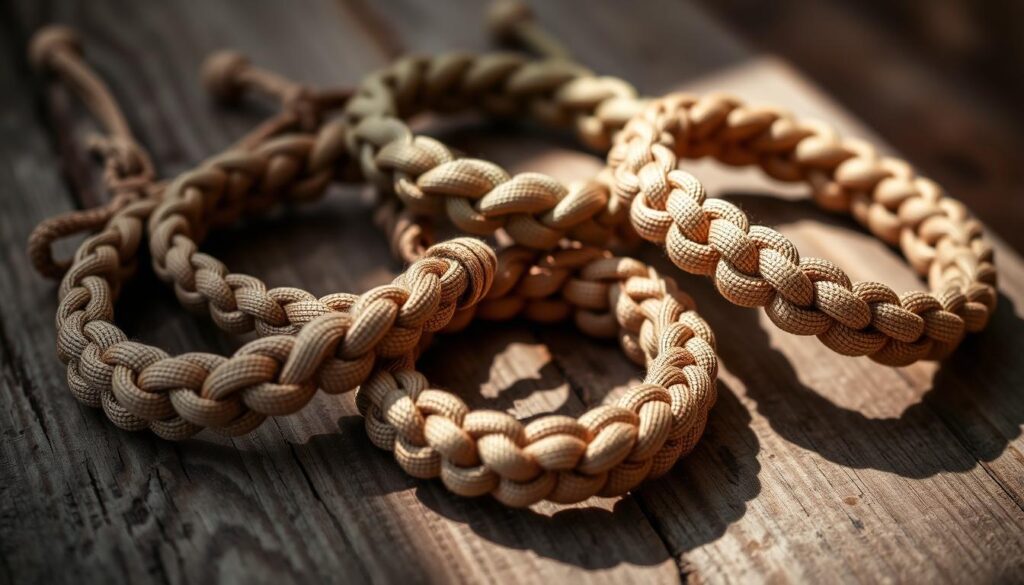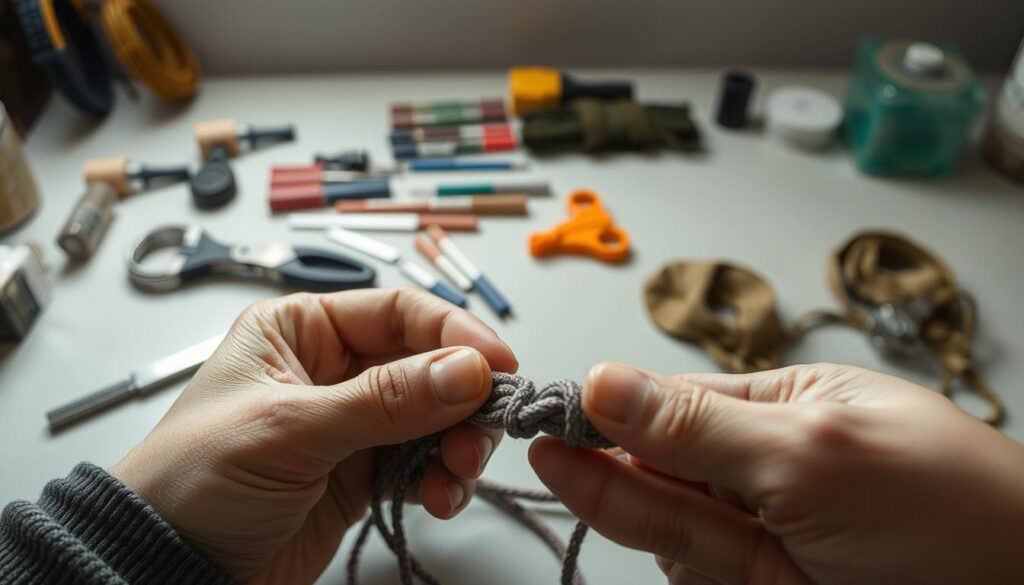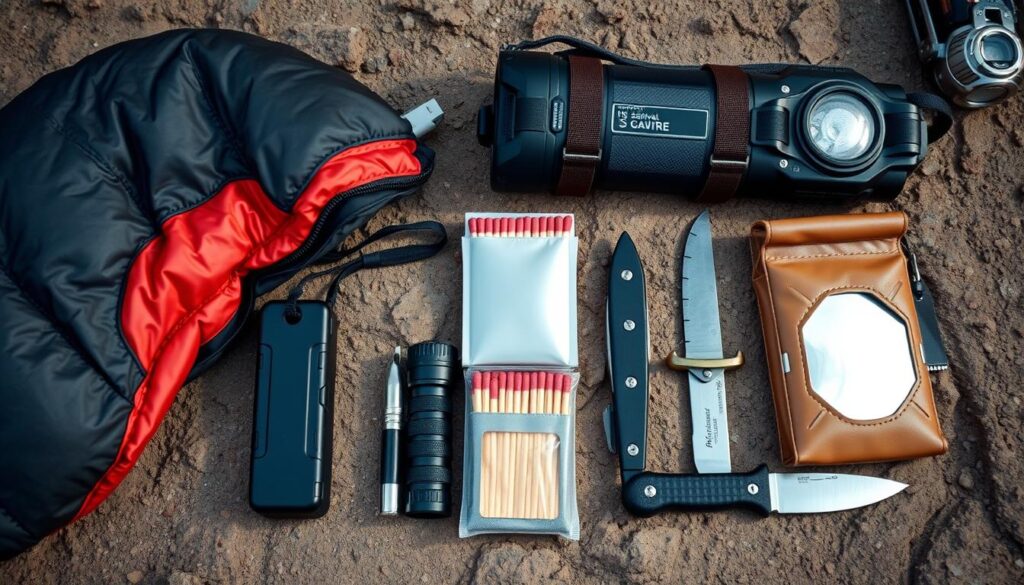Paracord crafting has become a fun hobby for many. It mixes creativity with practical uses. Originally made for military parachutes, paracord is a strong nylon rope. It’s great for making useful items and decorations.
Starting with paracord can be both thrilling and a bit confusing. To begin, check out a detailed guide like the one on paracord crafting for beginners. It teaches you the basics and shares project ideas.
This guide is here to help you dive into the world of paracord crafting. Whether you want to make useful bushcraft gear or just enjoy making things, it’s for you.
Key Takeaways
- Discover the versatility of paracord and its various applications.
- Learn basic knots and techniques for paracord crafting.
- Explore project ideas, from simple accessories to complex survival tools.
- Understand the importance of proper care and maintenance for your paracord creations.
- Find inspiration for advanced techniques and unique projects.
Introduction to Paracord
Exploring paracord crafting starts with knowing what paracord is and why it matters. Paracord, short for parachute cord, is a strong and light nylon rope. It was first used in military parachutes.
What is Paracord?
Paracord is known for its strength and versatility. It’s a favorite for crafting, survival gear, and outdoor fun. The most common is 550 paracord, with a breaking strength of 550 pounds.
History and Origins
Paracord’s history goes back to World War II. It was used as a parachute suspension line. Its durability and reliability made it key for military use. Now, it’s used by civilians too.
Types of Paracord
There are many paracord types, each with its own strength and features. Here are a few:
- Type I: The lightest, with a breaking strength of 95 pounds.
- Type II: Used for general tasks, with a breaking strength of 225 pounds.
- Type III (550 Paracord): The most popular, with a breaking strength of 550 pounds.
- Type IV: For heavy-duty tasks, with a breaking strength of 750 pounds.
Knowing the different paracord types and their uses is key. Whether for survival or crafting, paracord’s strength and versatility are unmatched.
Essential Tools for Paracord Projects
Before starting paracord projects, knowing the essential tools is key. The right equipment greatly improves the quality and ease of your projects.
Necessary Tools for Beginners
Beginners need a few basic tools. These include:
- Scissors: For cutting paracord to the right length.
- Lighter: To melt and seal paracord ends, stopping fraying.
- Measuring Tape: For precise paracord measurements.
- Fid or Lacing Needle: Useful for working with paracord, like making knots or weaving.
Optional Tools for Advanced Crafting
As you get better at paracord crafting, you might want more tools. These include:
- Paracord Board: Helps organize and manage paracord strands.
- Marlin Spike: Great for tightening knots and working with cord.
Safety Equipment
Safety is important when working with paracord. You’ll need:
- Safety Glasses: Protect your eyes from debris when cutting or melting paracord.
- Work Gloves: Keep your hands safe from injuries when handling sharp objects or fire.
With these tools and safety gear, you’re ready for many paracord projects. You’ll enjoy making something useful and beautiful with paracord.
Basic Paracord Techniques
Learning basic paracord techniques is key to making the most of your crafting. These skills are the base for more complex designs. Knowing the basics lets you make a variety of paracord crafts that look good and work well.
The Right Knot for Every Application
Knowing how to tie the right knot is a basic skill in paracord crafting. Each knot has its own use, and picking the right one is vital for your craft’s durability and function. Here are some common knots:
- The Square Knot, perfect for joining two paracord ends together.
- The Wrap Knot, great for making a secure and adjustable loop.
- The Lark’s Head Knot, a simple way to attach paracord to a ring or other objects.
Measuring and Cutting Paracord
Measuring and cutting paracord accurately is another key skill. To have enough, measure out a length that’s several times longer than what you need. Cutting it cleanly is also important to avoid fraying. Use a sharp knife or scissors for a clean cut.
Sealing the Ends of Paracord
Sealing paracord ends is a must to prevent fraying and give your project a polished look. You can use a lighter to melt the fibers, apply glue, or use a special tool. The method you choose depends on your project’s needs.
Creating Paracord Bracelets
Making paracord bracelets is a fun way to explore paracord crafting. They are stylish and also useful for survival. You can wear them every day.

Step-by-Step Instructions
To begin, you need paracord, a buckle, and basic tools. First, measure your wrist to figure out how much paracord you need. Use about 1.5 times your wrist’s circumference.
Then, cut the paracord to the right length. Start your pattern. The cobra weave is a simple yet strong choice.
- Start with a simple knot to secure the paracord to the buckle.
- Begin the cobra weave pattern, ensuring to keep the tension even.
- As you near the end, secure the paracord with another knot and trim the excess.
Customizing Your Bracelet
Customizing your bracelet is the best part. You can play with colors and patterns. This lets you create something that shows who you are.
Think about adding beads or using different buckles. This will make your bracelet truly yours.
Popular Styles
There are many paracord bracelet styles. Some are simple, while others are more complex. The cobra weave is loved for its strength and look.
Other favorites include the Fishtail and King Cobra weaves. They offer different levels of complexity and beauty.
By trying different patterns and customizations, you can make a bracelet that’s both useful and stylish.
Paracord in Survival Situations
Paracord is key in survival, helping with shelter, fishing, and more. Its strength and flexibility make it essential in any survival kit.
Practical Applications Outdoors
Paracord has many uses outdoors. It can help build a shelter by tying branches together. It’s also great for pulling a stranded vehicle or helping someone in need.
It can also be a fishing line or a clothesline to dry clothes. Its uses are endless, boosting your survival skills.
Making Survival Gear
Paracord is great for making survival gear. You can craft a survival kit with a paracord fishing kit, a bow drill, or a tow line. First, measure and cut the paracord to the right length. Then, use it to make the gear you need.
For example, you can make a fishing line from paracord. Use the inner strands, add a hook and bait, and you have a lifesaving tool in a survival situation.
Emergency Situations and Solutions
In emergencies, paracord offers many solutions. It can be used to secure a makeshift bandage or sling. It can also help create a rescue line or start a fire with a bow drill.
Knowing how to use paracord is key in survival. By adding it to your survival kit and learning its uses, you can greatly improve your survival chances.
Advanced Paracord Projects
Exploring advanced paracord projects can take your crafting to new heights. These projects are both useful and beautiful. As you get better, you’ll find making complex items rewarding and challenging.
With advanced paracord projects, you can do more with this versatile material. You can make things like belts, dog leashes, and small accessories like keychains. The possibilities are endless.
Paracord Belts: A Detailed Guide
Making a paracord belt is a great way to show off your skills. First, measure your waist and pick your paracord color. Then, choose a buckle that fits your style. Here’s how to start:
- Measure your waist and cut the paracord to the right length.
- Pick a buckle that matches your style, whether it’s simple or fancy.
- Start weaving, using a method like the cobra weave for a thicker belt.
- Finish with a knot and trim any extra paracord.

Crafting Paracord Dog Leashes
A paracord dog leash is durable and stylish. You’ll need paracord, a leash handle, and basic tools. Here’s how to make one:
- Cut the paracord to the length you want for your leash.
- Make a loop at one end for attaching to the dog’s collar.
- Weave the paracord into a strong leash, using knots like the wrap knot.
- Attach the leash handle to the other end, making sure it’s secure.
Paracord Keychains: Small but Mighty
Paracord keychains are small but impactful. They’re perfect for practicing knots and can be customized. Here’s how to make one:
- Cut a piece of paracord and fold it in half.
- Tie a knot at the folded end for a loop for your keyring.
- Weave or knot the paracord into your desired pattern.
- Secure the end with a simple knot and trim the excess.
These advanced projects improve your paracord crafting skills. They also make functional and stylish accessories for everyday use or as gifts.
Color Combinations and Patterns
Make your paracord crafts stand out by learning about color and patterns. Paracord’s flexibility lets you try many colors and designs. This makes every project special.
Choosing the Right Colors
Choosing the right colors for paracord accessories is key. You can pick colors that go well together or contrast each other. For example, earthy tones like olive green and brown look natural. Bright colors like red and yellow make things pop.
For tips on picking great paracord colors, check out Paracord Planet’s guide.
Creating Patterns with Paracord
Making patterns with paracord takes patience and practice. Start with simple designs like the Cobra weave or Solomon bar. Then, try more complex ones as you get better.
| Pattern | Description | Skill Level |
|---|---|---|
| Cobra Weave | A classic pattern that involves weaving the paracord in a snake-like design. | Beginner |
| Solomon Bar | A pattern that involves creating a bar-like structure with the paracord. | Intermediate |
| Fishtail | A more complex pattern that involves intertwining the paracord to create a fishtail-like design. | Advanced |
Elevating Your Design Skills
To get better at designing, try different colors and patterns. Don’t worry about making mistakes. They’re part of learning. With practice, you’ll make paracord crafts that look good and work well.
Repair and Maintenance of Paracord Projects
Paracord maintenance is more than just looks. It’s about keeping your gear lasting longer. Taking good care of it can greatly improve its durability and function. This is true for survival, fashion, or utility uses.

Cleaning Your Paracord Items
Regular cleaning of your paracord is key. Dirt and grime can weaken it over time. To clean, use mild soap and lukewarm water.
Gently scrub with a soft-bristled brush to remove dirt. Then, rinse well. Always dry your paracord naturally. Avoid heat to prevent damage to the nylon.
Repairing Worn or Damaged Paracord
If your paracord is damaged, you might need to fix or replace it. For small issues, you can re-apply the ends or re-knot. But for big damage, it’s better to replace it.
Regular checks can spot problems early. This way, you can fix them before they get worse.
Storing Paracord Properly
Storing paracord right is important. Keep it in a cool, dry spot, away from sunlight. Sunlight can fade colors and damage the material.
Coiling or hanging your paracord can prevent tangles. This makes it easy to use when you need it.
By following these easy maintenance tips, you can make your paracord gear last longer. It’s a smart investment of your time, whether you’re new or experienced with paracord.
Community and Resources
Being a paracord enthusiast opens up a world of resources and inspiration. The paracord community is full of opportunities for crafters to learn and share. It’s a vibrant network that helps everyone grow.
Online Forums and Groups
Online forums and groups are great for starting your paracord journey. Websites like Reddit have subreddits for crafters to share and discuss. Facebook groups and forums also offer a lot of information and help from experienced crafters.
Joining these communities can really help you learn and get inspired. You can share your work, get feedback, and learn about new trends and techniques.
YouTube Channels for Inspiration
YouTube is full of paracord tutorials and project ideas. Channels focused on paracord offer step-by-step guides for all skill levels. Subscribing to these channels keeps you inspired and up-to-date with paracord crafting.
Some YouTube channels focus on survival, while others focus on creativity. This variety means you can find content that matches your interests and skill level.
Books and Guides on Paracord
For those who like learning from books, there are many resources. These books range from beginner guides to advanced manuals. They cover everything from basic paracord and knot-tying to complex patterns and designs.
Books on paracord crafting are valuable for learning new techniques and understanding paracord’s history and versatility. Whether you want to improve your skills or explore new ideas, these guides are a great addition to your library.
Tips for Selling Paracord Crafts
As more people want handmade paracord accessories, crafters have a great chance to make money. If you want to sell your paracord crafts, there are important strategies to follow. This will help your business succeed.
First, know your market well. Find out who might buy your crafts and what they need. Market research helps you make products that people want. For example, do your crafts fit with outdoor lovers or fashion fans? Knowing this helps you make and market your products better.
Understanding Your Market
To really get to know your market, follow these steps:
- Find your special spot in the paracord world.
- Ask people who might buy your crafts what they think.
- Look at what others are doing to see what you can do better.
Jeff Johnson, a seasoned entrepreneur, said, “Knowing your customer is key to success.” This is very true for selling paracord crafts. What people like can really affect how much they want to buy.
Pricing Your Products Right
Setting the right price is tricky. You want to make money but also keep prices low enough to attract buyers. Think about how much materials cost, how long it takes to make each craft, and what similar things cost. Pricing your paracord crafts competitively is important to keep customers coming back.
Start with a good price and then change it based on what people say and how well you sell. This way, you can keep your prices right for your customers.
Promoting Your Creations Online
Today, you need to be online to show off your crafts. Use social media, online stores, and your own website to share your work. High-quality product images and clear descriptions can really help draw in buyers.
Places like Instagram and Etsy are great for showing off handmade items. Talking with your followers can help you build a loyal group of customers.
By knowing your market, pricing right, and promoting online, you can sell your paracord crafts and make a good business out of your hobby.
Seasonal Paracord Projects
As the seasons change, so do the opportunities for creative paracord projects. Whether you’re looking to create something functional or decorative, paracord can be a versatile material to work with throughout the year.
Holiday-Inspired Crafts
During holidays, paracord can be used to create unique gifts or decorations. For instance, you can make paracord ornaments for Christmas or paracord gift tags for birthdays. These projects not only showcase your creativity but also provide a practical application for paracord.
Some ideas include creating paracord wreaths for your front door or using paracord to make decorative accents for your holiday gifts. The durability of paracord ensures that these items can be enjoyed for years to come.
Summer Outdoor Gear
Summer is a great time to enjoy the outdoors, and paracord can be used to enhance your outdoor experiences. You can create paracord camping gear, such as hangers or clotheslines, that are easy to set up and take down.
Also, paracord can be used to make custom gear like belts or bag straps that are both functional and stylish. The versatility of paracord makes it an ideal material for outdoor enthusiasts.
Winter Survival Tools
When winter arrives, paracord can be a vital component of your survival kit. You can use it to create emergency shelters or securing gear in snowy conditions.
Some practical winter projects include making paracord snow anchors or creating a paracord emergency signaling device. These projects highlight the importance of paracord in survival situations.
Conclusion: The Endless Possibilities of Paracord
Reflecting on paracord crafting, I see endless creative options. From simple bracelets to complex belts, paracord’s versatility shines. It’s truly amazing.
Starting Your Paracord Journey
If you’re new to paracord crafting, start by checking out the techniques and projects in this article. With basic tools and practice, you can make unique items. The paracord community is full of inspiration and help.
Future of Paracord Crafting
The paracord community is growing, and new projects are coming. Whether you’re experienced or just starting, now is a great time to get into paracord crafting. It’s a hobby that’s fun, practical, and connects people.
Embracing the Craft
Paracord crafting is more than a hobby. It’s a way to express yourself, create something new, and meet like-minded people. I hope this article has inspired you to dive into paracord crafting and enjoy its many benefits.
FAQ
What is paracord, and what does it stand for?
Paracord, short for parachute cord, is a lightweight, versatile cord. It was first used in the military for parachute lines. It’s known for its durability and design with multiple strands.
What are the different types of paracord available?
There are several types of paracord, each with different strengths. Type I has a 95-pound test strength, Type II has a 225-pound test strength, and Type III has a 550-pound test strength. Type III, or 550 paracord, is the most popular.
How do I choose the right paracord for my project?
Choose paracord based on your project’s needs. Consider the strength, durability, and color needed. For most projects, 550 paracord is a good choice because it’s strong and versatile.
What are some essential tools for paracord crafting?
You’ll need scissors or a sharp knife for cutting, and a lighter to melt the ends. A measuring device is also essential. Optional tools include a paracord reel, cord stoppers, and various buckles or clasps.
How do I seal the ends of paracord to prevent fraying?
To seal the ends, carefully melt them with a lighter. Rotate the end as you apply the flame. This ensures an even melt and prevents charring.
Can I customize my paracord bracelet?
Yes, you can customize your bracelet by choosing different colors and patterns. You can also try various knots and designs to make it unique.
How do I clean and maintain my paracord projects?
Clean your projects with mild soap and water. Avoid harsh chemicals and dry them thoroughly to prevent mold. Regularly check and repair worn parts to extend their life.
Can paracord be used in survival situations?
Yes, paracord is very useful in survival situations. It’s strong, durable, and versatile. You can use it for shelter, securing gear, and even as a makeshift tow line.
Where can I find inspiration and resources for paracord crafting?
Find inspiration and resources online, on YouTube, and in books. Joining the paracord community can also give you valuable insights and ideas.
How can I sell my paracord creations?
To sell your creations, understand your market and find your niche. Price your items competitively. Use social media and craft marketplaces to promote your work.
Are there seasonal paracord projects I can make?
Yes, you can make projects for different seasons. For example, holiday-themed crafts, summer camping accessories, and winter survival tools.



